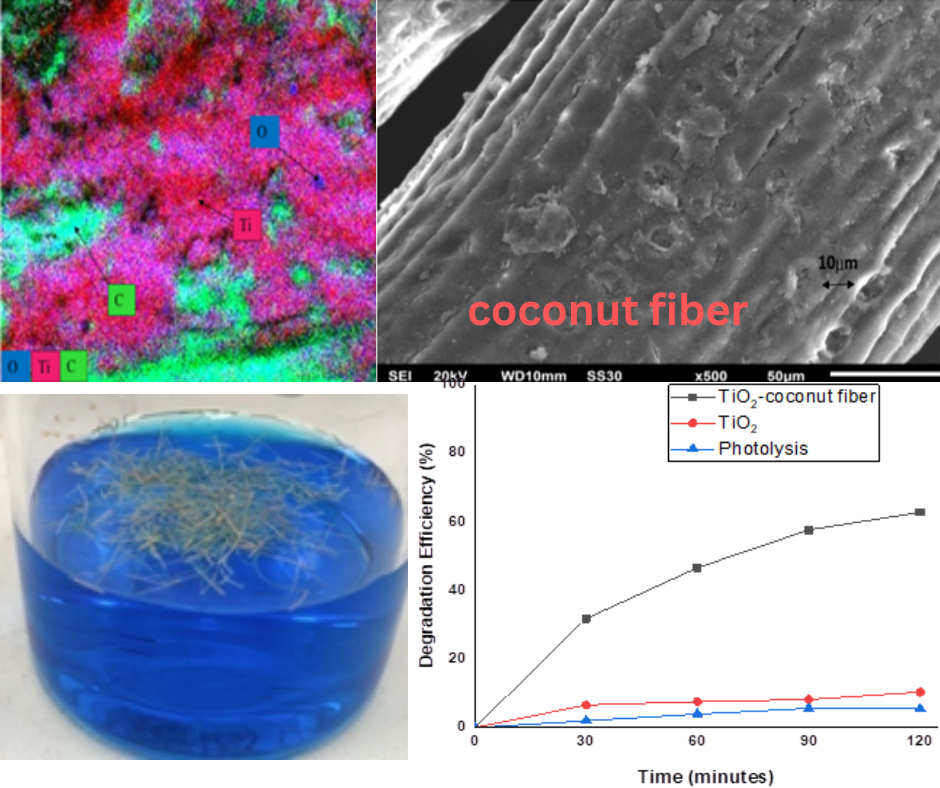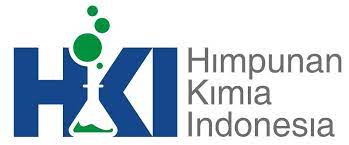
Fotocatalytic degradation of methylene blue by floating TiO2-coconut fiber
Authors
Didiek Sugandi , Nelly Wahyuni , Winda RahmaliaDOI:
10.29303/aca.v7i1.183Published:
2024-04-19Issue:
Vol. 7 No. 1 (2024)Keywords:
Floating photocatalyst, TiO2, Methylene blue, TiO2-coconut fiberArticles
Downloads
How to Cite
Downloads
Metrics
Abstract
Indonesia's expanding industrial sector has resulted in an increase in the use of dyes. Methylene blue (MB), a dye used in the batik and textile industries, has the potential to be detrimental to people and the environment. Recent research indicates that the TiO2 photocatalyst has the ability to reduce MB. TiO2 transported in coconut fiber can improve illumination in the photocatalysis process. The purpose of this study is to examine the properties and activity of a TiO2-coconut fiber photocatalyst. SEM-EDX was used to characterize the morphology and composition of floating catalysts, and Fourier transform infrared (FT-IR) was used to characterize the functional groups. At 120 minutes, TiO2-coconut fiber photocatalysis with a mass ratio of 20:80 w/w demonstrated the maximum degradation of 62.72%. The SEM-EDX data demonstrate the morphology of TiO2 distribution on the surface of coconut fiber, which is distinguished by the presence of the main elements O, Ti, and C. The FT-IR study results demonstrate a shift and decrease in Ti-O absorption intensity from 756,09 cm1 to 721,38 cm1, indicating the presence of Ti-O-C bonds. It is hoped that this research will be useful in the treatment of MB in textile industry waste or other organic waste.
References
Hardian, A., Putri, R. H., Budirman, S., & Syarif, D. G. (2021). Sintesis Keramik Komposit ZrO2-ZnFe2O4 sebagai Fotokatalis Magnetik untuk Degradasi Metilen Biru. ALCHEMY Jurnal Penelitian Kimia,17(1), 43-53.
Salazar-Rabago, J. J., Leyva-Ramos, R. J., Rivella-Utrilla, R., Ocampo-Ferez., & Cerino-Cordova, F. J. (2017). Biosorption Mechanism of Methylene Blue from Aqueous Solution Onto White Pine (PhinusDurangensis) Sawdust: Effectof Operating Conditions. Sustainable Environmental, 27(1), 32-40.
Astuti, F. (2018). Efek Fotodegradasi pada Pengolahan Surfaktan Anionik dari Limbah Laundry.Jurnal Ilmiah Teknik Kimia, 2(1),19-24.
Deka, P. T. (2019). Perbandingan Proses Fotodegradasi pada Zat Warna Metil Jingga
Menggunakan Zeolit, Katalis Fe2O3-zeolit dan Sinar UV. Pharmasci, 4(2), 71-76.
Joshi, K. M., & Shirivastva, V. S. (2010). Removal of Hazardious Textile Dyes from Aqueous Solution by Using Commercial Activated Carbon with TiO2 and ZnO as Photocatalyst.International Journal of Chem Tech Research, (2), 427-435.
Putro, R. K. H., Setiawan, Y. A.,& Tuhu, A. R. (2019). Degradasi Surfaktan (linier alky benzene) pada Limbah laundry dengan Metode Fotokatalis ZnO. Jurnal Envirotek, 11(1), 25-30.
Hendra., Barlian, E., Razak, A., & Sanjaya, H. (2015). Photo-Degradation of Surfactant Coumpounds Using UV Rays with Addition of TiO2 Catalysts in Laundry Waste.Jurnal Sains dan Teknologi, 7(1), 66-75.
Andari, N. D., & Wardhani, S. (2014). Fotokatalis TiO2-Zeolit untuk Degradasi Metilen Biru. Chemistry Progress, 7(1), 9-14.
Destiarti, L., Tjokronegoro, R., Rakhmawaty, D., & Rudiansyah. (2015). The use of TiO2-SiO2 in Photocatalytic Process to Degrade Toxic and Dangerous Waste.Makara Journal of Science, 19(1), 1-6.
Mohammadi, Z., Sharifnia, S., & Shavisi, Y. (2016). Photocatalytic Degradation of Aqueous Ammonia by Using TiO2/ZnO/LECA Hybrid Photocatalytic. Materials Chemistry and Physic, 184, 110-117.
Xing, Z., Zhang, J., Cui, J., Y-kain, J., Zhao, T., Kuang, J., Xiu, Z., Wan, N., & Zhou, W. (2018). Resent Advance in Floating TiO2–Based Photocataliysts for Environmental Application. Aplied Catalysis B. Environmental, 225, 452-467.
Astika, M., Lokantara, P., & Karohika, M. G. (2013). Sifat Mekanis Komposit Polyester dengan Penguat Serat Sabut Kelapa.Jurnal Energi dan Manufaktur, 6(2), 115-122.
Sugandi, D., Agustiawan, D., Wijayanto, E., Vebriyanti, L. M. L., Panaya, G. Y. L., & Wahyuni, N. (2023). Sunlight Assisted Degradation of Linier Alkylbenzene Sulfonate by Floating Catalyst TiO2-Coconut Fiber. POSITRON, 13(1), 69-76.
Abel, U. A., Habor, G. R., & Oseribho, O. I. (2020). Adsorpion Studies of Oil Spill Clean-up Using Coconut Coir Activated Carbon (CCAC). Journal of Applied Chemistry, 13(3), 42-56.
Setiawan, A., Anggraini, F. D. M., Ramadani, T. A., Cahyono, L., & Rizal, M.C. (2021). Pemanfaatan Jerami Padi sebagai Bioplatik dengan Menggunakan Metode Perlakuan Pelarut Organik. Media Komunikasi Rekayasa Proses dan Teknologi Tepat Guna, 17(2),69-80.
Septevani, A. A., Buhani, D., & Sudiyarmanto. (2018). Pengaruh Proses Pemutihan Multi Tahap Serat Selulosa dari Limbah Tandan Kosong Kelapa Sawit. Jurnal Kimia dan Kemasan, 40(2), 71-78.
Ancastami., Azwar, E., Lismeri, L.,&Santoso, R. (2020). Pengaruh Konsentrasi Asam Formiat dan Waktu Reaksi pada Proses Delignifikasi Metode Organosolv dari Limbah Batang Pisang. INOVASI PEMBANGUNAN, 8(2), 147-159.
Rasyad, A., & Arto, B. (2018). Analisis Pengaruh Temperatur, Waktu, dan Kuat Arus Proses Elektroplanting Terhadap Kuat Tarik, Kuat Tekuk dan Kekerasan pada Baja Karbon Rendah. Jurnal Rekayasa Mesin, 9(3), 173-182.
Setiawan, A., Ramadani, T. A., & Ashari, M. L. (2020). Sintesis dan Karakterisasi Komposit Fiber Sabut Kelapa Sawit dengan Resin Epoksi. Jurnal Teknologi Terapan, 6(1), 76-83.
Agustiani, T., Saefumillah, A., &Ambarsari, H.S. (2021). Studi Pemanfaatan Limbah Biomassa sebagai Raw Material Adsorben SIC dalam Penurunan Konsentrasi Amonia Sebagai Parameter Bau dalam Air Limbah. JurnalTeknologi Lingkungan, 22(2), 190-198.
Aprilia, W. R., & Haris, A. (2016). Sintesis Semikonduktor TiO2 Serta Aplikasinya pada Dye-Sensitized Sola Cell (DSSC) Menggunakan Dye Indigo Carmine. Jurnal Kimia Sains dan Aplikasi, 19(3), 111-117.
Bakre, P. V., & Tilve, S. G. (2018). Direct Access to Highly Crystalline Mesoporous TiO2 using Sterically Bulky Organic Acid Templates. Journal of Physics and Chemistry of Solid, 116:234-240.
Monariqsa, D., Oktora, N., Azora, A., Haloho, D. A. N., Simanjuntak, L., Musri, A., Saputra, A., & Lesbani, A. (2012). Ekstraksi Selulosa dari Kayu Gelam (Melaleuca Leucadendron Linn) dan Kayu Serbuk Indusi Mebel. JurnalPenelitianSains, 15(3), 96-101.
Dewi, A. M. P., Kusumaningrum, M. Y., Edowai, D. N., Pranoto, Y., & Darmadji, P. (2017). Ekstraksi dan Karakterisasi Selulosa dari Limbah Ampas Sagu, Prosiding Seminar Nasional Sains dan Teknologi 2017 (pp. 6-9). Semarang: Fakultas Teknik Univesitas Wahid Hasyim.
Ahmad, Z., Roziaizan, N. N., Rahman, R., Mohamad, A.F.,& Ismail, W.I.N.W. (2016). Isolation and Characteriation of Microcrystallie Cellulose (MCC) from Rice Husk (RH). MATEC Web of Conference, 47, 1-6.
Fitri, W., & Mora. (2018). Pengaruh Persentase Serbuk Ampas Tebu Terhadap Sifat Fisik dan Mekanik Papan Semen Partikel.Jurnal Fisika Unand, 7(4), 367-373.
Qurban, M. A., Wafar, M., Jyothibabu., & Manikadan, K. P. (2017). Patterns of Primary Production in the Red Sea. Jounal of Marine Sysytem, 169, 87-98.
License
Copyright (c) 2024 Didiek Sugandi, Nelly Wahyuni, Winda Rahmalia

This work is licensed under a Creative Commons Attribution-NonCommercial-ShareAlike 4.0 International License.
Authors who publish with ACA: Acta Chimica Asiana agree to the following terms:
- Authors retain copyright and grant the journal right of first publication with the work simultaneously licensed under a Creative Commons Attribution-NonCommercial-ShareAlike 4.0 International License. This license allows authors to use all articles, data sets, graphics, and appendices in data mining applications, search engines, web sites, blogs, and other platforms by providing an appropriate reference. The journal allows the author(s) to hold the copyright without restrictions and will retain publishing rights without restrictions.
- Authors are able to enter into separate, additional contractual arrangements for the non-exclusive distribution of the journal's published version of the work (e.g., post it to an institutional repository or publish it in a book), with an acknowledgement of its initial publication in ACA: Acta Chimica Asiana.
- Authors are permitted and encouraged to post their work online (e.g., in institutional repositories or on their website) prior to and during the submission process, as it can lead to productive exchanges, as well as earlier and greater citation of published work (See The Effect of Open Access).





 Indonesian Chemical Society, Chapter Nusa Tenggara. Jalan Majapahit 62 Mataram, University of Mataram, 83125, Indonesia
Indonesian Chemical Society, Chapter Nusa Tenggara. Jalan Majapahit 62 Mataram, University of Mataram, 83125, Indonesia





